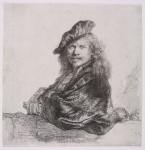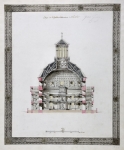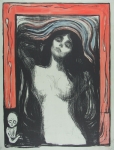The Print Room
of the Warsaw
University Library
56/66 Dobra Street
00-312 Warsaw
e-mail: gabryc.buw@uw.edu.pl
tel.: (22) 55 25 830
OPENING HOURS
Tuesday and Thursday
10.00 – 18.00
16th to 18th century OLD MASTER PRINTS
The Library Print Room boasts objects from nearly all schools and periods of European graphic arts (the majority of them from the 17th and 18th century) and – less numerous – polonica. The most outstanding collections include early (15th-16th century) Italian and German engravings (Andrea Mantegna, Marcantonio Raimondi and his school, all series of prints by Albrecht Dürer). The 16th century Netherlands and 17th-18th century Flemish and Dutch schools are reflected in the works of Lucas van Leyden, Antwerpian Sadeler family (religious cycles, portraits), Jacob Matham (alegories, religious scenes, genre scenes), Adriaen van Ostade (peasant scenes), Wallerant Vaillant and others. Moreover, the Print Room houses a magnificent collection of impressions (woodcuts and copper engravings) from Rubens school which represent Rubens’ paintings (Lucas Vorsterman, Paulus Pontius, Boetius and Schelte à Bolswert, Christoffel Jegher and others) and the largest in Poland collection of Rembrandt van Rijn’s graphic works.The 16th to the 18th century Italian school involves the most outstanding engravers and painters dedicated to graphic arts: the inventor of monotype technique Giovanni Benedetto Castiglione, the poet and landscape painter Salvator Rosa, the author of numerous polonica (including 2,5 m The entry of Jerzy Ossoliński to Rome) Stefano della Bella, Venicians: Marco Alvise Pitteri, the architect Michele Marieschi (vedutes), and Tiepolo family (caprices, Scherzi). Attention should be drawn to the unique collection of nearly complete graphic œuvre of Giovanni Battista Piranesi and his son Francesco (ancient monuments, contemporary architecture in Rome, Carceri) from King Stanisław August Poniatowski’s library.French masterpieces of the 17th and 18th century include the eminent etchings by Jacques Callot (landscapes, caprices, the cycle Les misères de la guerre) and copper engravings by outstanding portraitists Robert Nanteuille and Gerard Edelinck. The collection abounds in French and English color prints (Gilles Demarteau, Louis M. Bonnet, Jean-François Janinet, Pierre-Louis Debucourt, William Wyne Ryland, Francesco Bartolozzi) and English mezzotints (Richard Earlom, John R. Smith, Valentin Green).Finally, the Print Room holds a unique collection of chiaroscuro woodcuts from the period of the 16th to 18th century, the largest collection of that type in Poland (over 200 impressions), including works of the 16th and 17th century masters such as Ugo da Carpi (see Diogenes on the cover of this guide).
16 TH TO 20TH CENTURY MASTER DRAWINGS
The collection of highly diverse nature includes approximately 3500 drawings by masters of various European schools (often represented with only one work), Polish artists and foreign artists active in Poland. Most eminent objects originate from the collections of King Stanisław August Poniatowski, Stanisław Kostka Potocki and Warszawskie Towarzystwo Przyjaciół Nauk (the Friends of Science Society in Warsaw).The abundant collection of works from the Italian school (the 16th to 18th century) includes pieces by such artists as Perino del Vaga, the painter and biographer of other artists Giorgio Vasari, Francesco Salviati, Alessandro Allori, Bartolomeo Passarotti, one of few woman painters Elisabetta Sirani and Giovanni Battista Piranesi (architectural fantasies). Equally outstanding names draw attention to the collection of 16th century Netherlands and 17th century Flemish and Dutch works including the design of stained-glass window by Pieter Coeck van Aelst, miniatures from the circle of Frans Floris documenting the marriage of the Duke of Parma Alessandro Farnese to the Duchess Mary of Portugal, landscape masterpieces by Paulus Bril, Roelant Savery and Esaias van de Velde, and, last but not least, the magnificent pieces by Peter Paul Rubens, Jacob Jordaens and Rembrandt van Rijn.French school is primarily reflected in the works of 18th century artists: François Boucher’s designs of coats of arms for Polish Commonwealth and King Stanisław August Poniatowski, the drawings by Charles Natoire, Jean B. Oudry and Edme Bouchardon, red chalk landscapes and the collection of contre-epreuves from the studies on ancient monuments by Jean-Honoré Fragonard. Less impressive collection of works by German artists (many pieces are anonymous) nonetheless includes items by such important 16th century masters as Hans Suess von Kulmbach or Hans van Aachen. Drawings of Polish artists and foreigners active in Poland are included in large collections of works by Jan Chrystian Kamsetzer (created during his travel to the Orient and Italy), Franciszek Smuglewicz (designs for paintings, studies on ancient Greece and Rome, ancient history, judaica), Józef Wall, Ferdynand Pinck and Zygmunt Vogel.Nineteenth and twentieth century drawings are dominated with works of Polish masters: Wincenty Smokowski, Jan Matejko, Leon Wyczółkowski, Józef Pankiewicz, Franciszek Siedlecki, Józef Mehoffer, Tadeusz Makowski, Wacław Wąsowicz and Zbysław Marek Maciejewski, to mention only a few of them. The output of European artists of that period is reflected in the pieces by Constantin Guys, Félicien Rops and Emil Orlik.
Architectural and decorative drawings
The highly valuable collection of architectural and decorative drawings (over 3500 items) is closely related to Polish history and culture. It includes the archives of Tylman van Gameren and the second half of the 18th century and first half of the 19th century designs, mostly originating from King Stanisław August Poniatowski’s royal collection complemented with the collections of Dominik Witke-Jeżewski, Stanisław Patek, Sapieha family from Dereczyn and Lubomirski family from Łańcut.Unique on a European scale archives of Tylman van Gameren, an architect and military engineer who settled in Poland in 1666, include over 800 drawings: designs of ecclesiastical buildings (the Sisters of the Holy Sacrament church, the Bernardine church in Czerniaków district), epitaphs and tombstones, palaces (Krasiński Palace), villas, manor houses, public service buildings and fortifications.Equally interesting is King Stanisław August Poniatowski’s collection which provides priceless resources for research on the Enlightenment architecture and town planning as well as the output of most famous contemporary architects: Jakub Fontana, Domenico Merlini, Jan Chrystian Kamsetzer, Efraim Schröger and Jakub Kubicki. Particularly important are designs for rebuilding the Royal Castle in Warsaw (the architectural drawings by Victor Louis and interior designs by the sculptor and interior decorator Jean-Louis Prieur). Another set of drawings concerns Łazienki Palace, Ujazdów, Świątynia Opatrzności (the Temple of Providence), St John Cathedral and residences in Grodno, Jordanowice, Białystok, Wiśniowiec, etc. The royal collection is complemented with Witke-Jeżewski and Patek’s collections constituting so-called „Minter Portfolios” – the collection which belonged once to Colonel Wilhelm H. Minter, the engineer and director of military buildings. The designs included in the collection, mostly concerning Warsaw and its immediate vicinity, were related to the bourgeoisie and aristocracy patronage. Next to numerous works of Szymon Bogumił Zug (around 500 items: palaces, tenement houses, churches, etc.) the collection includes designs created by Wilhelm Minter and royal architects.Small yet interesting set of designs included in the collection formerly owned by Eustachy Sapieha from Dereczyn is related to Aleksander Sapieha’s funding activity and Jan S. Becker’s architectural output. Less valuable set of designs from the Łańcut collection (drawings signed by Jan Griesmayer, Chrystian Piotr Aigner, Jakub Hempel and Franciszek Maria Lanci) reflects the architectural activity of Izabella Lubomirska and Potocki family in their family estates in Łańcut, Lwów and Vienna.
19th AND 20th century prints
The collection relatively well documents the development of lithography with works of foreign (Jean Auguste Dominique Ingres, Achille Deveria, Honoré Daumier, Gavarni) and Polish artists (in particular the pioneer impressions of Count Aleksander Chodkiewicz and the lithographies by Jan Feliks Piwarski and Maksymilian Fajans).The beginnings of modern graphic arts are represented by the works of outstanding European, Polish and American graphic masters from the second half of the 19th century and early 20th century, including the French: Camille Corot, Felix Bracquemond, Edouard Manet and Henri de Toulouse-Lautrec, the Germans: Max Liebermann, Lovis Corinth, Max Slevogt and the Belgian: James Ensor and Félicien Rops (more than 200 works in the collection). The output of English and American artists is reflected in prints by Frank Brangwyn, Joseph Pennell and James McNeil Whistler while Scandinavian pieces primarily include the works of Edvard Munch and Anders Zorn. Attention should be drawn to a large collection of works by Czech graphic artist Emil Orlik.The comprehensive collection of contemporary Polish prints and drawings includes the works of Leon Wyczółkowski, Józef Pankiewicz, Władysław Skoczylas, Feliks Jabłczyński, Józef Mehoffer, Franciszek Siedlecki, Konstanty Brandel, Jan Skotnicki, Jan Rubczak, Wojciech Weiss, Karol Mondral and Tadeusz Makowski and considerably large sets of pieces by illustrators such as Stefan Mrożewski, Stanisław Ostoja-Chrostowski and Tadeusz Cieślewski Jr. Achievements of graphic artists from the second half of the 20th century are shown in the works of Jonasz Stern, Jerzy Panek, Józef Gielniak and Jan Dobkowski.









